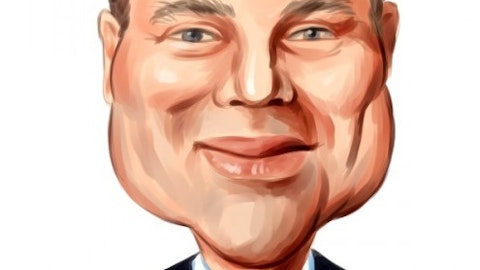Now incentives are of our take rate. And as we said, incentive spend has been down pretty substantially on a year-on-year basis. And so that is a tailwind on our take rate — but otherwise, what we want to do is to maximize long-term free cash flow growth, maximize long-term earnings per share at the lowest take rate that we can because it drives us to be more efficient as a business going forward. So we try not to kind of push take rate opportunistically, because the cycle is going to move the other way and when it moves the other way, it’s really going to hurt if you’re not structured with a low cost base.
Ken Gawrelski: Thank you.
Dara Khosrowshahi: You’re welcome. Next question?
Operator: Our next question comes from Michael Morton with MoffettNathanson. Please go ahead.
Michael Morton: Hi, thank you for the question. Wanted to talk a little bit about the new growth opportunities in mobility. In the past Dara, you’ve spoken about aspiration for reserve penetration of like total airport trips. And I’d love to know if we’re seeing the product in the market for some time now. How you see this opportunity, how large it could get reserves as a percentage of airport bookings? And then looking outside of travel and airport bookings, maybe the impact you think reserve could have on the other aspects of the mobility business? And then just a second question, a quick one. On your advertising product, you’ve really made a lot of progress since rolling this out. And I would love to learn some more about how you believe your offering meets the needs from large enterprises.
It seems like there’s a lot of demand for the large sophisticated enterprises, but they are more demanding when it comes to advertising solutions and the product has historically been overweight to kind of SMBs. So, any update there would be great as well. Thank you so much.
Dara Khosrowshahi: Yes, absolutely. So, in terms of reserve, listen, reserve is a very, very promising product continues to grow at significant rates. But it’s still pretty early in terms of reserve development. We typically now account for one out of the four legs of the airport. If you go to the airport, you get picked up and then you come back and you get picked up, et cetera, we typically only cover one out of those four legs. So, we think that increased penetration at airport is absolutely a significant opportunity for us, and we’re very early in that penetration. I do think that reserve as a product, while it’s very good at picking up at your home, dropping off at the airport or picking up at your hotel and getting you to the airport on your way back, I think we can do a lot more in terms of experience for the rider who is arriving in the airport.
We have you put in your flight information so that the driver knows when you’re arriving. We automatically account for delays, et cetera. You can upload the information from your Hulu calendar onto our product, et cetera. So, there’s a lot that we’ve done. There’s some hyper optimization to be done in terms of arrivals and generally for airport pricing algorithms whereas we were pricing generally for the market, now we’re focused on really the airport experience. And I think the airport experience in terms of finding where the pickup area is, the pricing, the supply that we have in our airports is something that — it’s best of breed. But frankly, I think we can improve on. We are seeing some reserve usage for other types of use cases going out to dinner, et cetera.
And there, we think it’s about optimizing the premium that reserve represents over UberX versus the reliability. And there is a trade-off there. If you want the 99.9% reliability in reserve, the premium over UberX on Demand will be quite high. And on a market-by-market basis and kind of on a consumer segment by consumer segment basis, we’re trying to optimize what’s that trade-off between price and reliability that can maximize our reserve volume and again, we think there’s a lot more optimization to be done there. In terms of advertising for large entities, I think your question is spot on in that the majority of our ad revenue at this point is SMBs, et cetera. It’s a pretty simple pay for audience and pay for additional business model. The return on ad sales are excellent.
Return on ad sales are on average, anywhere from 7x to 10x your spend. So, this is a very profitable endeavor for our product for our partners, which is great. We are building out more sophisticated technology for our larger advertisers that, frankly, will also offer to our smaller advertisers. They may be, for example, amongst other products, the ability to target new customers and then being able to track those new customers when they become repeat customers. For grocery products, for example, is to integrate their membership and loyalty programs into Uber Eats so that their loyalty — their loyalty consumers can go direct or they can go through Eats and kind of in that way, they get to build the relationship with those loyalty members as well.
We are working increasingly on building out tool sets that can help larger advertisers measure the incrementality of the advertising and not just the return on ad sales of that advertising as well. And then we’re also helping our larger advertisers with dayparts. They may, for example, we’ve had certain larger advertisers. We really want to promote breakfast and want to go over promote breakfast, because it’s something — introducing, and we allow kind of daypart targeting as well. So all of these are relatively newer tools, and we think those tools are going to get a higher penetration of the larger advertisers, both in our Uber Eats business, but just as importantly, CPG advertisers for our grocery business. And of course, we got into the branded business in our Mobility segment and our Delivery segment as well.
So we think we’re well on our way to $1 billion plus, which was a target for our ad business that we set a few years ago. And we continue to be very, very pleased with our progress. And there’s a lot of potential in this business. So we’re not nearly even midstream in terms of its development.
Michael Morton: Thank you.
Dara Khosrowshahi : All right. Next question. I think we got one more.
Operator: Our next question comes from Mark Mahaney with Evercore. Please go ahead.
Mark Mahaney: Okay. Thanks. Two questions, please. You talk about this net headcount being down roughly 1% sequentially and looking for ways to demonstrate further operating leverage going forward. Are you at a point now where you can roughly keep headcount flattish or just growing low single-digit percent for the foreseeable future? And then secondly, you talk about in the next earnings call, I think over next quarter, you’re going to provide an update on returning capital to shareholders. Could you I know you’ll make that announcement then, but what are the options, a reasonable range of options that investors should think about with that? Thanks a lot.





